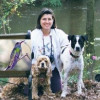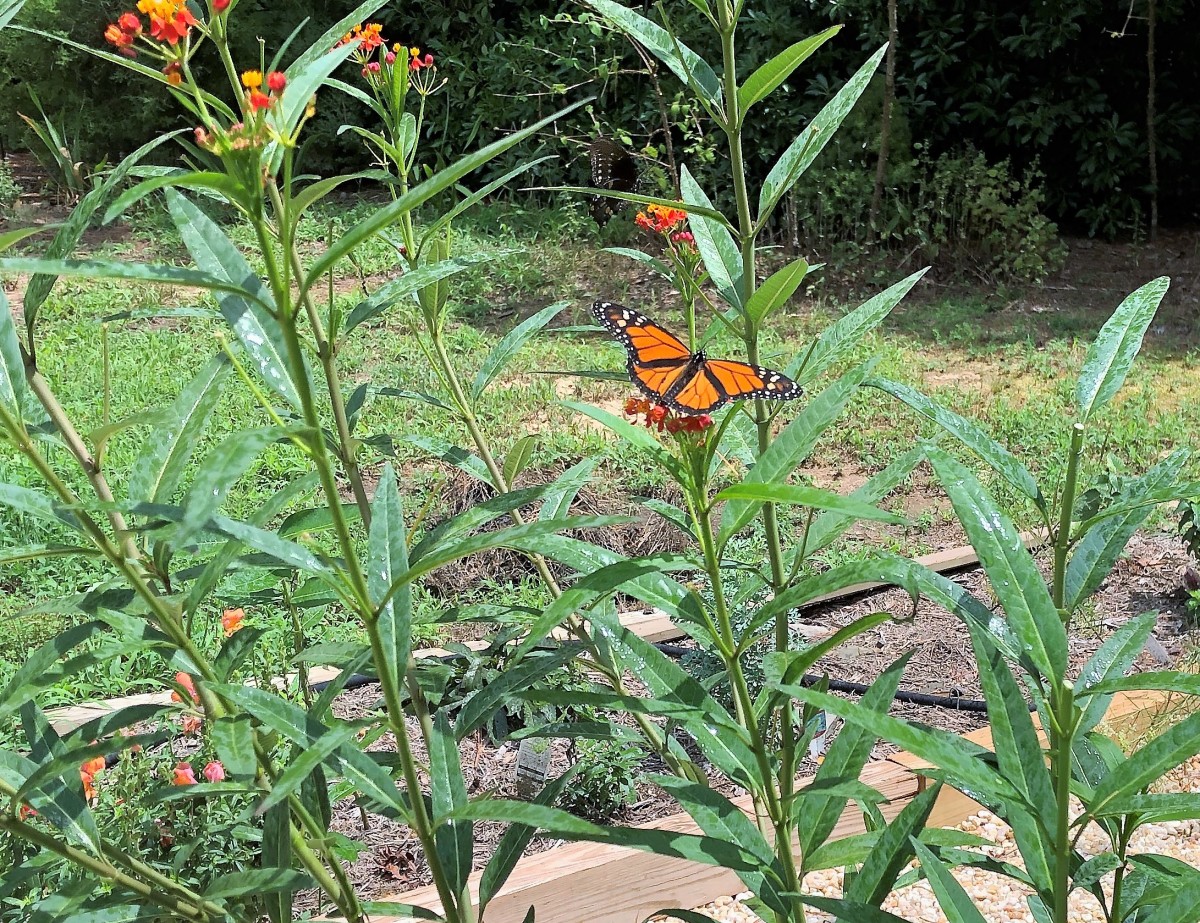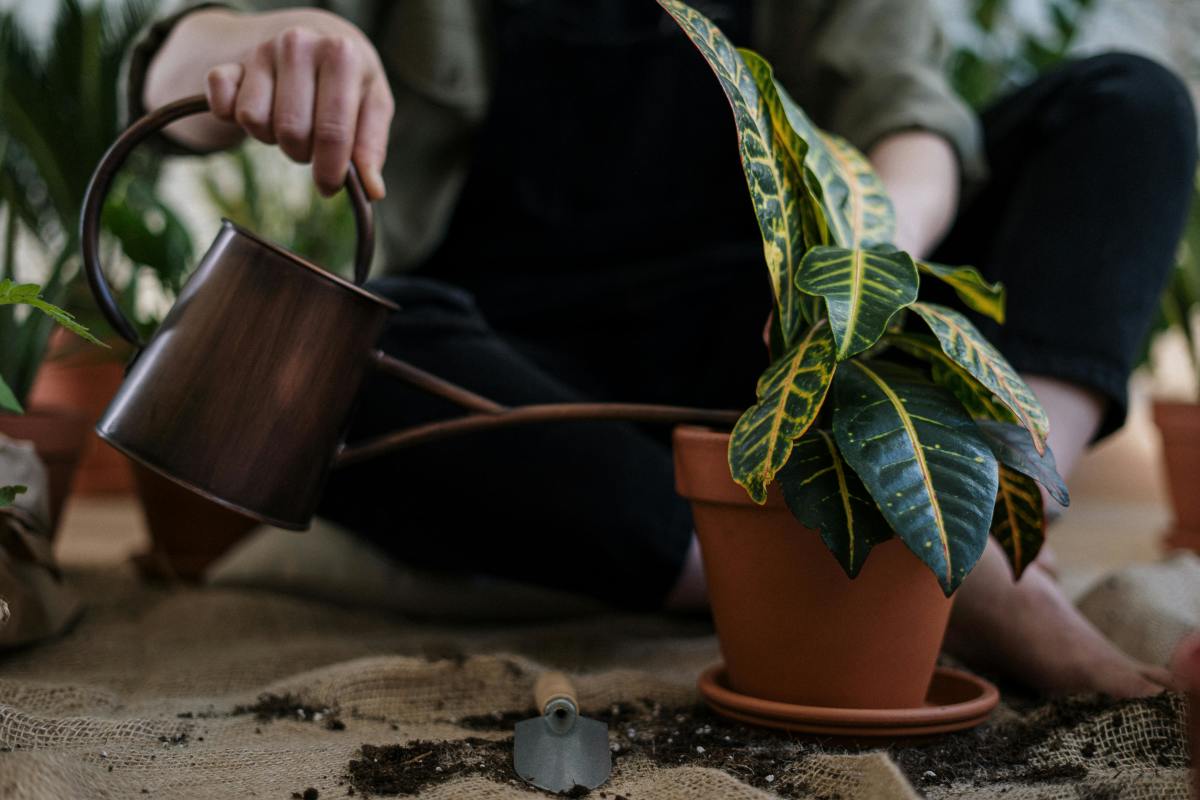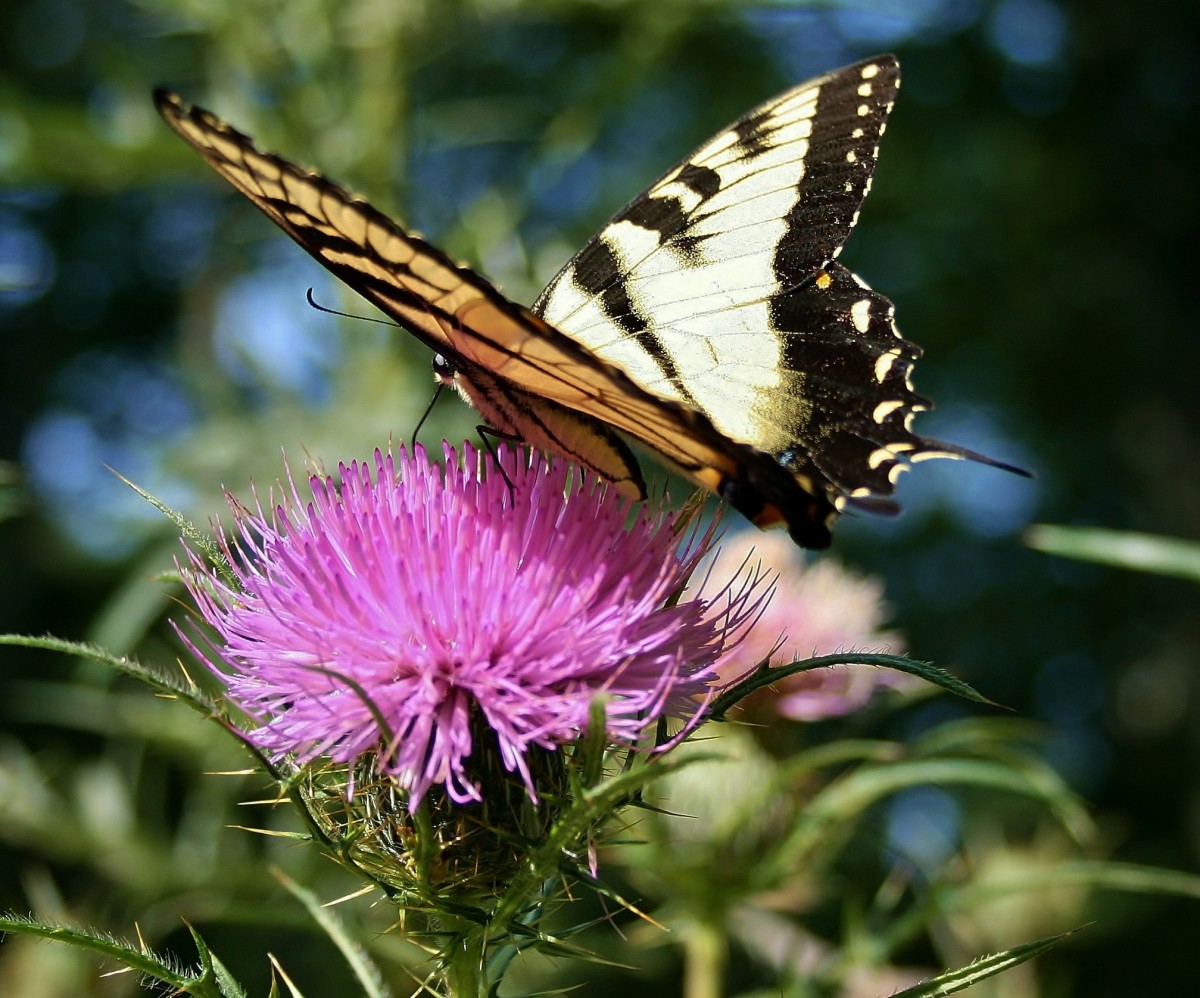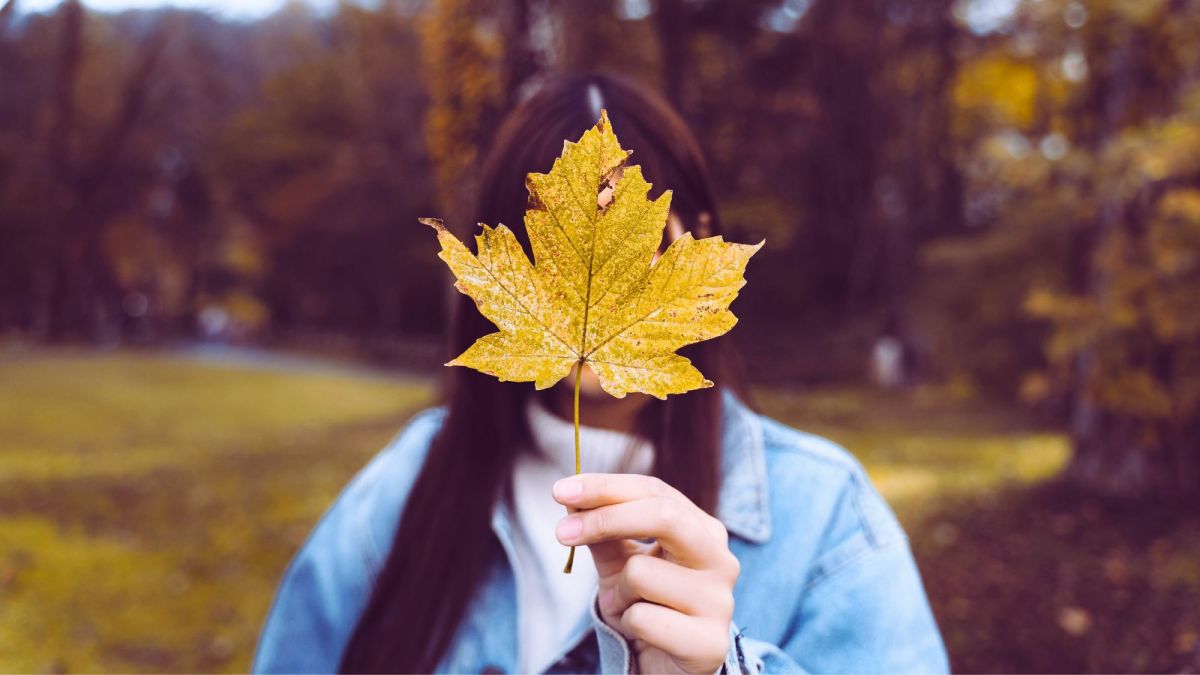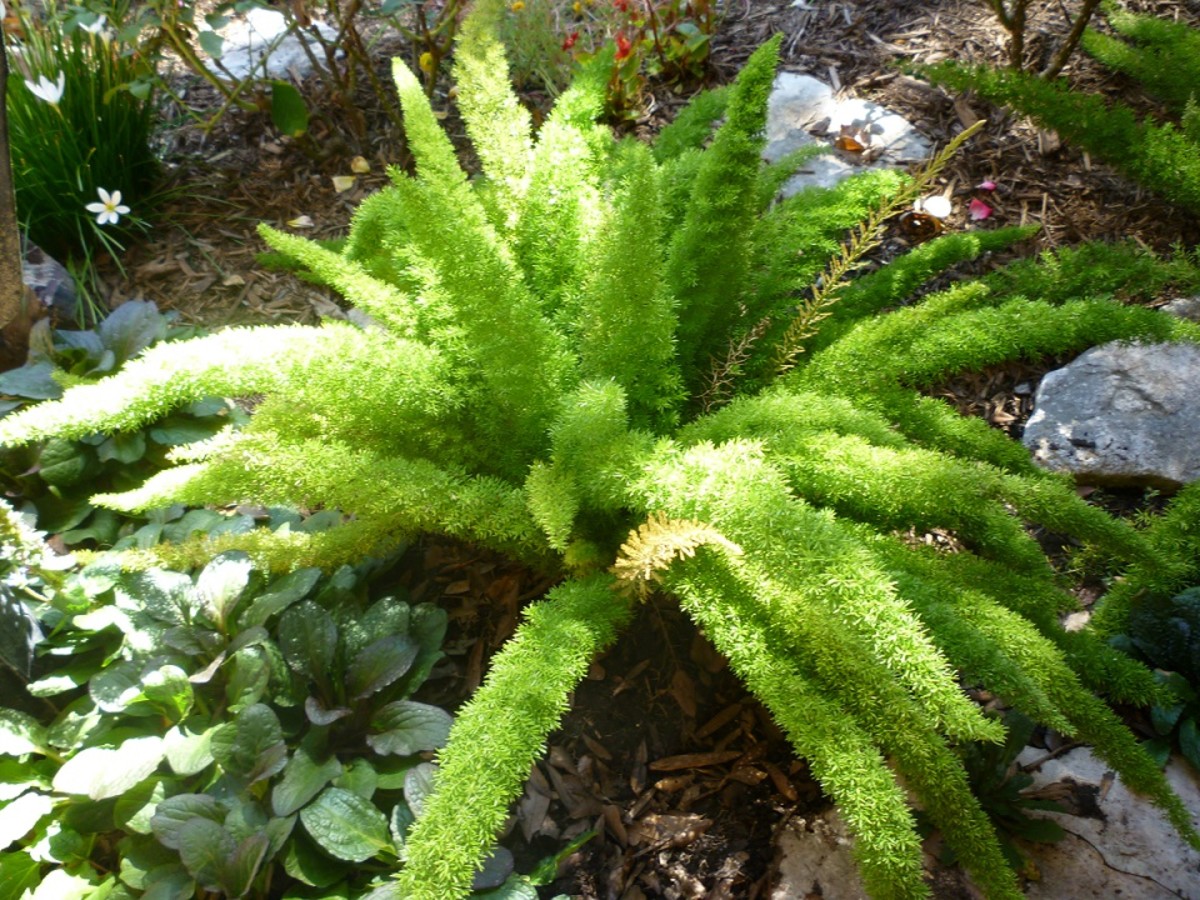Butterflies and Gardening to Attract Them
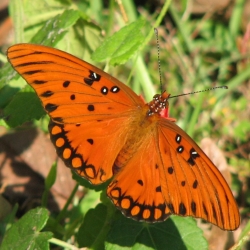
Butterfly Gardens
What is more beautiful than a garden full of colorful flowers with gorgeous butterflies flitting around? It's really not that hard to create a haven for these lovely insects right in your own yard. All you need to create this sanctuary for you and the butterflies are some nectar plants, host plants and a little elbow grease.
Here you'll find lists of many butterflies and their host (larval) plants and photographs of both. Lots of easy to grow nectar plants are listed as well. You'll also find books about butterflies and gardening to attract them for both adults and children.
~~~~~~~~~~~~~~~~~~~~~~~~~~~~~~~~~~~~~~~~~~~~~~~~~~
May the wings of the butterfly kiss the sun
And find your shoulder to light on,
To bring you luck, happiness and riches
Today, tomorrow and beyond.
An Irish Blessing
~~~~~~~~~~~~~~~~~~~~~~~~~~~~~~~~~~~~~~~~~~~~~~~~~~
Monarch on Purple Wild Asters
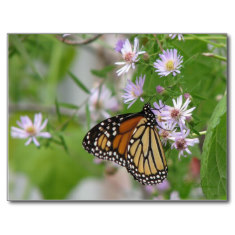
Sulfur on Salvia coccinea
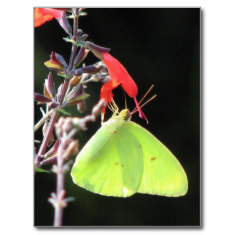
Butterfly Nectar Plants
A garden filled with beautiful, nectar rich flowers will attract butterflies to your yard. Butterflies require much smaller amounts of nectar than do hummingbirds, so almost any flower that is used by hummingbirds will be used by butterflies. Butterflies like flat-topped, composite flowers that are easy to sit on. A rule of thumb when choosing nectar plants for the butterfly garden is to stick to native and "old-fashioned" imported plants. Most of the newer, showy hybrid plants were bred for color or flower size, not nectar content and seed production as Mother Nature intended, so most have very little nectar.
Butterfly Gardening for the South
Sulfur on Firespike
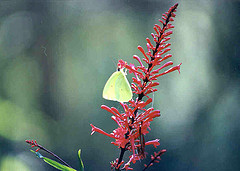
Louisiana Blue Phlox
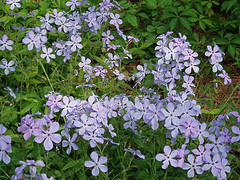
Some of our favorite butterfly nectar plants are Zinnas, Coreopsis, Marigolds, Cypress Vine, Red Morning Glory, Day Lilies, Irises, Butterfly Bush, Turk's Cap, Phlox, Black Eyed Susans and other members of the Rudbeckia family, Salvia, Tithonia, Azaleas, Mist Flower, Pickerel-weed, Lantana, Jamaican Vervain and wild Asters.
Most of these are perennials and easy to grow annuals. Our yard is large and there are only the two of us to plant and maintain it, so we try to keep it simple. No fussy, wilting Nellies are allowed in our yard. We'll try almost anything once, but if it doesn't do well in our hot, humid climate, then we try something else, or we just plant a native in it's place.
The photos of the butterflies on various flowers show many of the nectar plants that butterflies use. I think I have included one of each of the favorite nectar plants that we grow in our garden. Just put your mouse on the photo to see the name of the butterfly and the plant.
Black Swallowtail on Zinnias
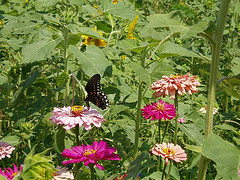
Attracting Butterflies & Hummingbirds Book
Coreopsis
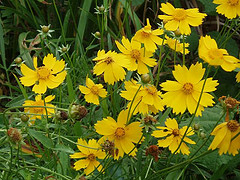
Features of a Butterfly Garden
Besides plenty of nectar plants for the adults and host plants for the caterpillars, there are some other important elements that should be present in the Butterfly Garden.
Pink Native Azalea
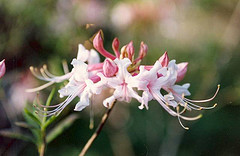
Red Bud Tree
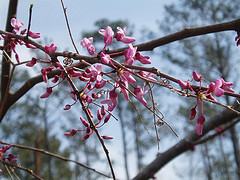
Shelter from the Wind is important because a butterfly's wings are fragile. A fence or group of evergreen shrubs that form a wind break on the north side of the garden will be appreciated by the butterflies. It will also help to reduce energy costs in winter.
A Shallow Water Feature or Boggy Area with a sandy or muddy bottom for those butterflies that like to "puddle".
Large Rocks for basking in the sun. Because butterflies are cold-blooded creatures, they need to warm up in the sun on cool spring mornings.
A Compost Pile or Overripe Fruit will be appreciated by some kinds of butterflies like Snout-nosed and Red-spotted Purple.
Rocks for Sunning
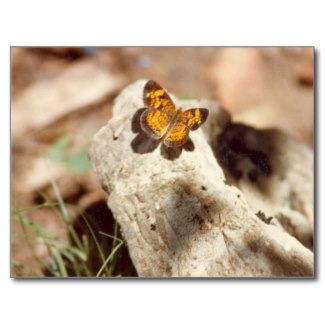
Available at Naturally Native Creations
Species of Butterflies and Their Host Plants
Monarch on Purple Asters
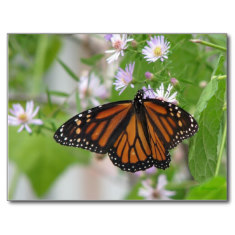
Swallowtail on Tithonia
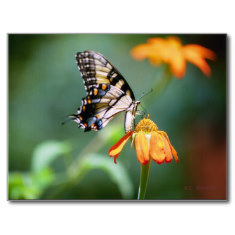
Available at Naturally Native Creations
While beautiful nectar rich flowers planted in large groups will attract butterflies to your garden, just that alone is not enough to keep them there. The most important plants in a butterfly garden are those "weeds", herbs, shrubs and trees that provide food for butterfly larvae. Many of these host plants have beautiful flowers.
Some examples are Passion Vine, the viola (Violet) family, snapdragons and False Foxglove. Most plants that are used by butterfly larvae and other insects are native to the United States.
Many scientists believe that the increase in alien (imported) plants directly affects the decline of butterflies and other insects because most of the alien plants that are not related to any of our natives can not be eaten by these insects. This, in turn, affects the number of birds and other animals that an area can support; when the insects leave or die out, the birds move to another area where insects are prevalent.
Members of the Citrus family, like this imported Satsuma, are the host plant of the Giant Swallowtail Butterfly. These imported Citrus trees are related to some of our native plants, so they can be used by this butterfly.
Citrus Flowers
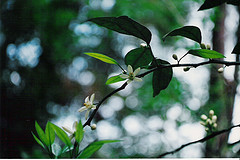
Planting native perennials, shrubs and trees will have many positive effects on your yard. In addition to providing food for beautiful butterflies, natives will improve the soil, help conserve water, alleviate flooding, save money and decrease pollution. If you are concerned about the holes that the larvae make in the leaves, then hide the host plants away in a back corner.
As with other wildlife gardening, pesticides of all kinds are prohibited. Bacillus thuringiensis should definitely not be used anywhere in a butterfly garden. This bacillus attacks caterpillars, the larval stage of butterflies and moths. It does not discriminate between a cabbage loper and a Tiger Swallowtail.
Gulf Fritillary on Maypop Passion Vine
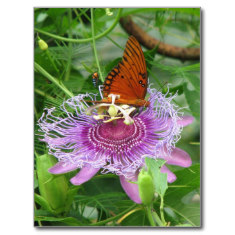
National Wildlife: Attracting Birds, Butterflies...
Painted Lady on Cat's Whiskers
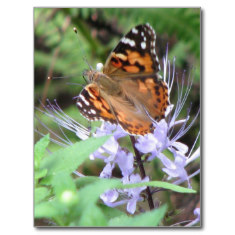
Available at Naturally Native Creations
Continue reading to see pictures of many of the butterflies which are common to Southeastern Louisiana and some of their larval food plants.
List of Host Plants by Butterfly
Various Butterflies and Their Host Plants
Each kind of butterfly needs a specific group of plants on which to lay its eggs. Providing these larval food plants will increase the number of butterflies in your garden. Here is a list of southern U.S. butterflies and some of their most common host plants.
Swallowtails
Eastern Tiger (Papilia glaucus) - Leaves of Cottonwood, Tulip Tree, Sweet bay, Cherry and others
You can find more information about the Eastern Tiger on Butterflies - Tiger Swallowtail.
Eastern Tiger Swallowtail on Pickerel Weed
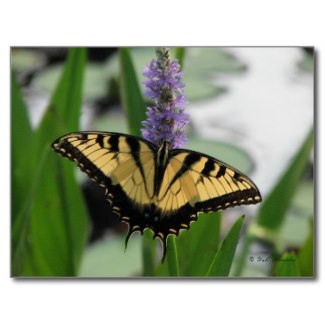
Available at Naturally Native Creations on Zazzle
Zebra (Eurytides marcellus) - Paw Paw
Zebra Swallowtail
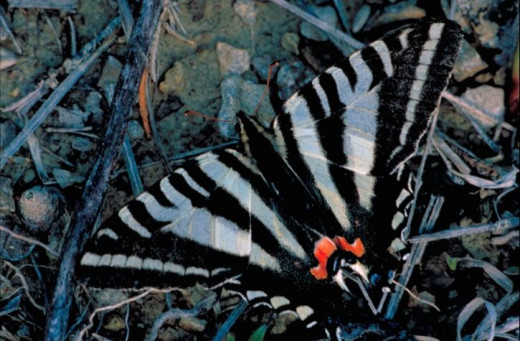
Pipevine on Coral Vervain
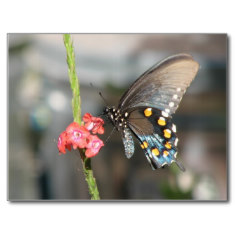
Pipevine (Battus philenor) - Pipevines
Available at Naturally Native Creations
Spicebush (Papilio troilus) - Spicebush, sassafras & other laurelsFor more information about the Spicebush Swallowtail, you may want to check out, Butterflies - Spicebush Swallowtail Pictures and Plants.
Spice Bush Swallowtail
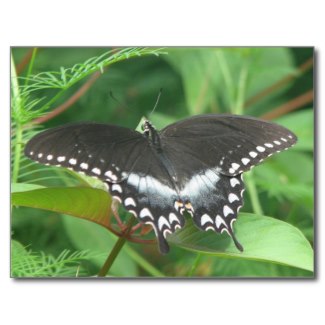
Adult Black Swallowtail
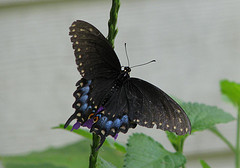
Available at Naturally Native Creations
Black (Papilio polyxenes) - Parsley family (dill, fennel, carrots, both cultivated and wild)
The Life Cycle of the Black Swallowtail Butterfly
Laying Eggs
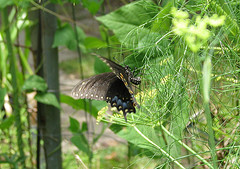
Black Swallowtail Caterpillars
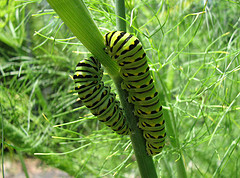
We plant a patch of parsley, fennel or dill in an area away from the garden just for the swallowtails.
Black Swallowtail Chrysallis
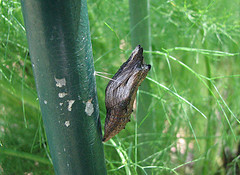
Palamedes Swallowtail on Vervain
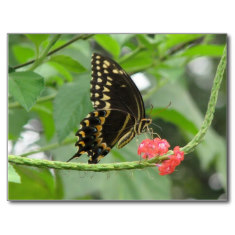
Sweet Bay Laurel Plant
Palamedes on Coral Vervain
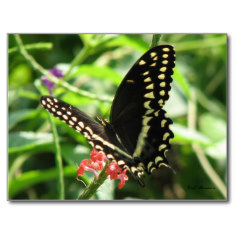
Satsuma is a type of Mandarine orange. It is cold hardy to about 20 degrees F.
Satsuma Orange Tree
Giant Swallowtail
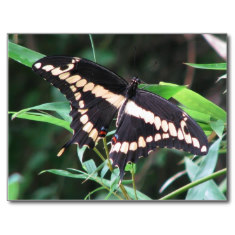
Available at Naturally Native Creations
Giant (Papilio cresphontes) - Citrus, wild lime, hop tree & other citrus relatives
The Life Cycle of the Giant Swallowtail Butterfly
Giant Swallowtail Lays Egg on Citrus Plant
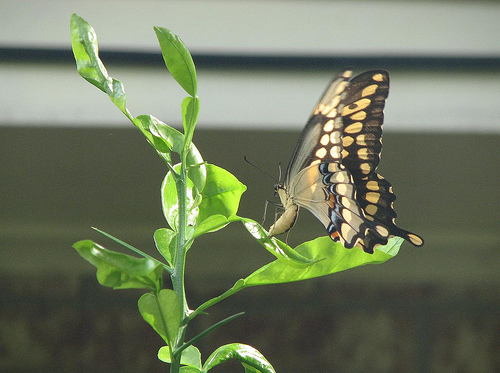
The Egg
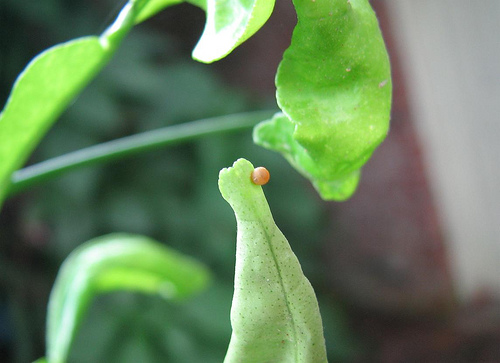
Caterpillar Looks Like Bird Poop
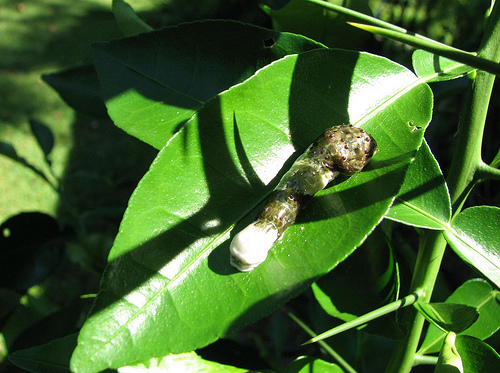
~~~~~~~~~~~~~~~~~~~~~~~~~~~~~~~~~~~~~~~~~~~~~~~~~~
The caterpillar does all the work but the butterfly gets all the publicity.
Attributed to George Carlin
~~~~~~~~~~~~~~~~~~~~~~~~~~~~~~~~~~~~~~~~~~~~~~~~~~
Whites, Sulphurs, Hairstreaks, Blues and Azures
Sulphur on Coral Nymph Salvia coccinea
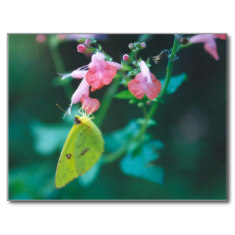
Sulphur on Turk's Cap
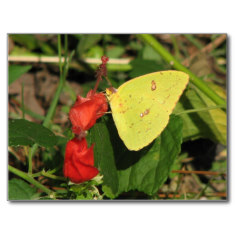
Available at Naturally Native Creations
Whites and Sulphurs
- Cabbage White (Pieris rapae) - Cabbage, nasturtium, watercress, various capers and mustards
- Checkered White (Pontia protodice) - Many native and exotic mustards
- Cloudless Sulphur (Phoebis sennae), Little Yellow (Eurema lisa), Sleepy Orange (Eurema nicippe) - Senna (Cassia family)
- Southern Dogface (Colias eurydice) & Clouded Sulphur (Colias philodice) - Indigo Bush, clovers & other legumes
Hairstreak on Goldenrod Mousepad
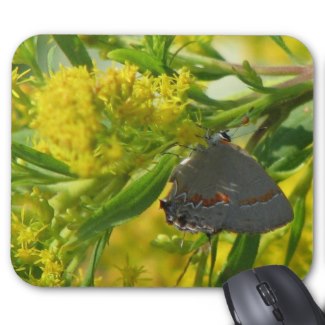
Available at Naturally Native Creations
Hairstreaks
- Gray Hairstreak (Strymon melinus) - Flowering parts of legumes, mallows and other plants
- White M Hairstreak (Parrhasius m-album) - Oaks
Blues and Azures
- Eastern Tailed-blue (Everes comyntas) - Flowers and seeds of many legumes
Eastern Tailed Blue Poster
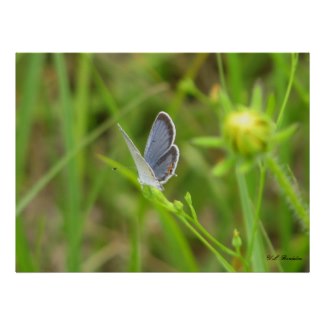
Buy Eastern Tailed-Blue Butterfly by naturegirl7
- Spring Azure Complex (Celastrina ladon) and "Summer" Azure (Celastrina ladon neglecta) - Flowering parts of many plants
Kaufman's is my favorite butterfly guide. It has detailed illustrations from different angles, accurate information and great maps.
Butterflies of North America Guide
Brush Footed Butterflies
Longwings and Fritillaries
- Zebra Longwing (Heliconius charithonia) Occasional visitor - Passion Vines
Zebra Longwing
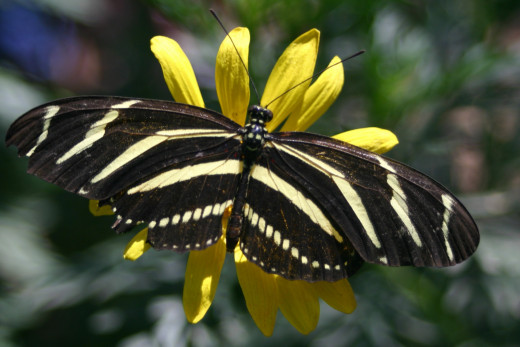
Gulf Fritillary (Agraulis vanillae) - Passion Vines (including the wild tiny yellow flowered Passiflora lutea L.)
Maypop Passion Flower Plant
Variegated Fritillary
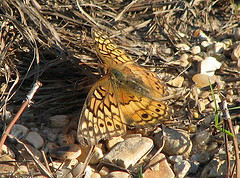
Available at Naturally Native Creations
Variegated Fritillary (Euptoieta claudia) - Passion vine, flax and viola family
Pansy (Viola) Seeds
Available at Naturally Native Creations
The Folsom Native Plant Society has a good page about growing Passion Vine. You will also find more information on Butterflies - Gulf Fritillary
The Life Cycle of the Gulf Fritillary Butterfly
Gulf Fritillary Lays an Egg on Passion Vine
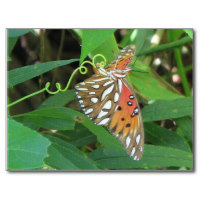
Gulf Fritillary butterflies love warm weather. Here in Louisiana, they reach peak numbers in the fall. One year there were hundreds of chrysalises hanging from the eaves and slats of the house. They looked like tiny ornaments. The yard was ablaze with the fluttering orange wings.
Egg is on a Tendril of the Vine
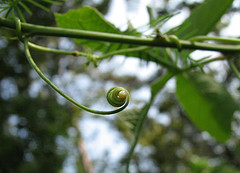
Caterpillar Sheds Skin as It Grows
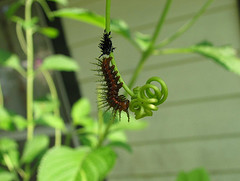
Stokes Butterfly Book

Almost Ready to Make a Chrysallis
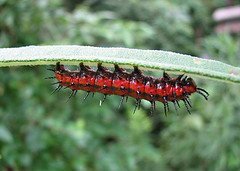
Caterpillars of Easter North America Guide

Pearl Crescent
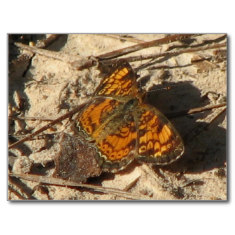
Available at Naturally Native Creations
- Pearl Crescent (Pyciodes tharos) - Asters
Coma Butterfly Poster
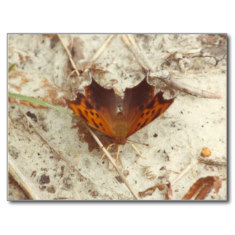
Available at Naturally Native Creations
Question Mark (Polygonia interrogationis) and Eastern Comma (Polygonia comma) - Hops, nettles, elms & hackberries
Available at Naturally Native Creations
Mourning Cloak (Nymphalis antiopa) - Willows, cottonwoods, elms, birches & hackberries
Mourning Cloak
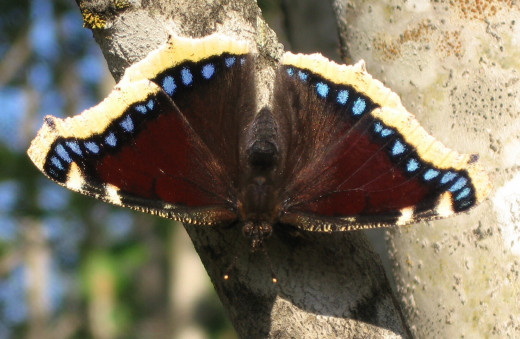
Red Admiral
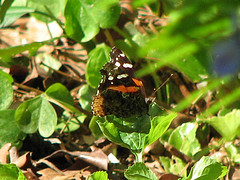
Red Admiral (Vanessa atalanta) - Nettles and false nettles
Audubon Field Guide to North American Butterflies
Painted Lady Poster
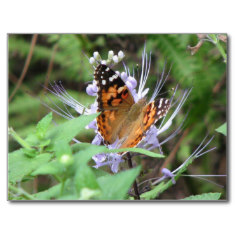
Available at Naturally Native Creations
American Lady (Vanessa virginiensis) and Painted Lady (Vanessa cardui) - Thistle and mallows
Buckeye Poster
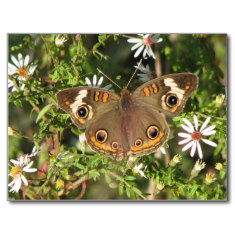
Available at Naturally Native Creations
Common Buckeye (Junonia coenia) - Plantains, snapdragons and False Foxglove
Peterson First Guide to Butterflies and Moths
Red Spotted Purple Postcard
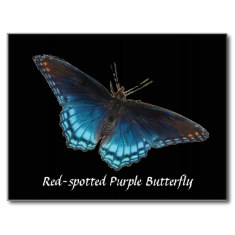
Available at Naturally Native Creations
Red Spotted Purple (Limenitis arthemis (in part)) - Willows, cottonwoods and poplars
Viceroy
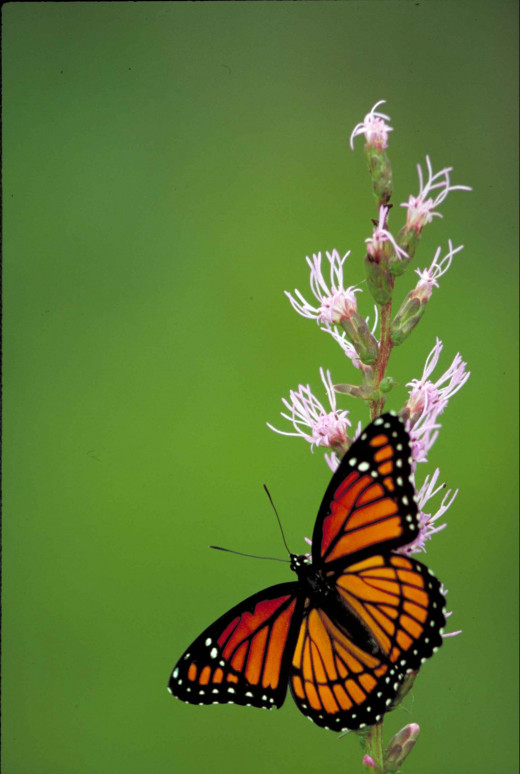
Available at Naturally Native Creations
Viceroy (Limenitis archippus) - Willows, sometimes poplars and others
Monarch on Lantana
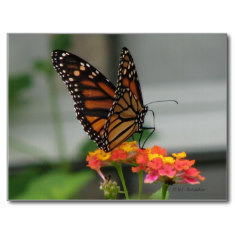
Emperors (Asterocampa spp) and Snouts (Libytheana spp.) - HackberriesMonarch (Danaus plexippus) and Queen (Danaus gilipus) - Milkweeds
You can find more information on Monarchs and Milkweed
Wintering Monarch Butterflies Video
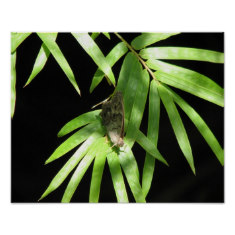
Satyrs, Wood-Nymphs, Browns, Pearly-eyes & Skippers
Satyrs, Wood-Nymphs, Browns & Pearly-eyes - Grasses
Posters and Postcards are Available at Naturally Native Creations
Long-tailed Skipper Poster
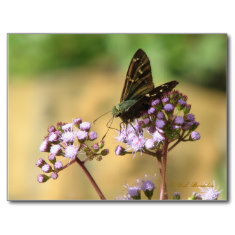
- Silver-spotted - Locusts, wisteria & legumes
- Long-Tailed & Cloudy wings - Legumes, especially beans
Butterflies of the East Coast Guide
Checkered Skipper on French Marigolds
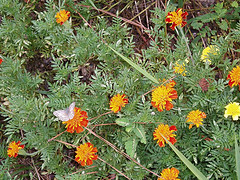
French Marigolds
Clouded Skipper on Coral Vervain
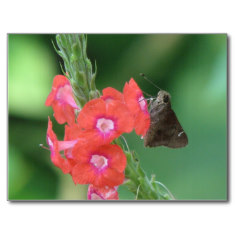
Grass Skippers (Fiery Skipper & others) - Bermuda grass & other grasses
Clouded Skipper
Whirlabout on Ham & Eggs Lantana
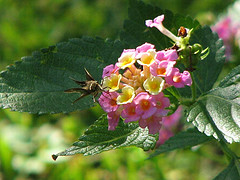
Brazilian - Cannas
This is the introduced butterfly whose larvae rolls up and eats the leaves of Canna lilies.
Hummingbird Moth on Monarda
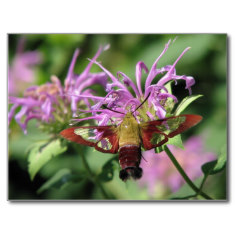
Hummer Moth on Pickerel Weed
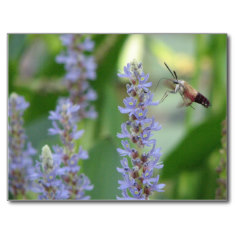
Clearwing Hummingbird Moth
One may think there's a tiny little baby hummingbird flying among the flowers, but more than likely it's a Hummingbird Clearwing Moth. This moth will feed during the day and it's shape, coloration and scaleless wings give it the appearance of a small hummingbird. There are two common varieties of this attractive and interesting member of the Sphinx moth family.
The two types of North American Hummingbird Moths are very hard to tell apart. One type is the Hummingbird Clearwing Moth or Clearwing Hummingbird Moth, which (as you can tell by its name) resembles a small hummingbird. The other is the Snowberry Clearwing Moth which actually looks more like a large bumblebee, than a hummingbird. The ranges of both species overlap quite a bit, so you can have both in a given location. Here are a couple of photos of the Hummingbird Clearwing Moth:
Butterfly Gifts for All Ages
Gifts for Butterfly Lovers
Here you'll find some lovely butterfly and flower jewelry, shirts, mugs, posters and other creations that would make nice gifts for Christmas, Valentine's Day, Mother's Day, birthdays or any special occasion.
~~~~~~~~~~~~~~~~~~~~~~~~~~~~~~~~~~~~~~~~~~~~~~~~~~
I've watched you now a full half-hour;
Self-poised upon that yellow flower
And, little Butterfly! Indeed
I know not if you sleep or feed.
How motionless! - not frozen seas
More motionless! and then
What joy awaits you, when the breeze
Hath found you out among the trees,
And calls you forth again!
William Wordsworth, "To a Butterfly"
~~~~~~~~~~~~~~~~~~~~~~~~~~~~~~~~~~~~~~~~~~~~~~~~~~
Red-spotted Purple Shirt
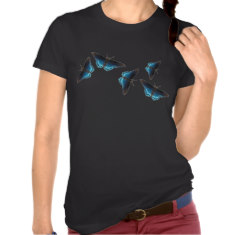
Butterflies to Wear, Use and Enjoy
Zazzle Products Designed by naturegirl7
We love to take photographs and draw and paint the natural world so we put together some products on Zazzle. Here are a few examples:
Monarch on Asters Mug
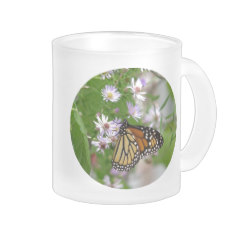
Buckeye on Wild Asters Stickers
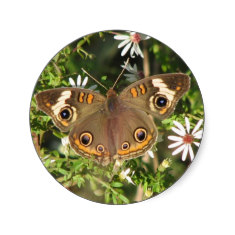
Louisiana Butterflies Poster
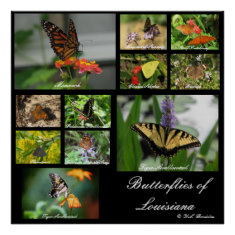
For More Designs and products, please visit our Naturegirl7 Creations Gallery.
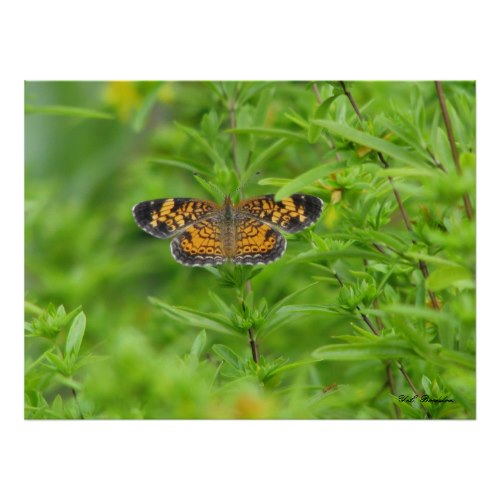
Pearl Crescent on St. John's Wort by naturegirl7
~~~~~~~~~~~~~~~~~~~~~~~~~~~~~~~~~~~~~~~~~~~~~~~~~~
Beautiful and graceful, varied and enchanting, small but approachable, butterflies lead you to the sunny side of life. And everyone deserves a little sunshine.
Jeffrey Glassberg
~~~~~~~~~~~~~~~~~~~~~~~~~~~~~~~~~~~~~~~~~~~~~~~~~~
Butterfly Plant Video
Great Books for the Larvae
Kid's Corner
Children find butterflies fascinating and what better way to teach them about insects and the cycle of life, than to observe the process of metamorphosis first hand. Get them out in the garden or bring a large caterpillar inside with lots of its host plant and keep it in a terrarium so the children can watch it make a chrysalis. If you keep the host plant in water, make sure that the caterpillar can't fall in and drown. Use a mason jar and punch holes in the jar lid so that the plant stems can go through, but the caterpillar can't. Also put in some woody branches so that it can crawl up and attach the chrysalis.
When the metamorphosis is complete and the butterfly exits the chrysalis and dries its wings, then the terrarium can be taken out into the garden so the butterfly can be released. Now the cycle is complete and it will reproduce as nature intended.
Monarch butterfly numbers are in peril. It's important that children learn the importance of butterflies and other insects in the ecosystem.
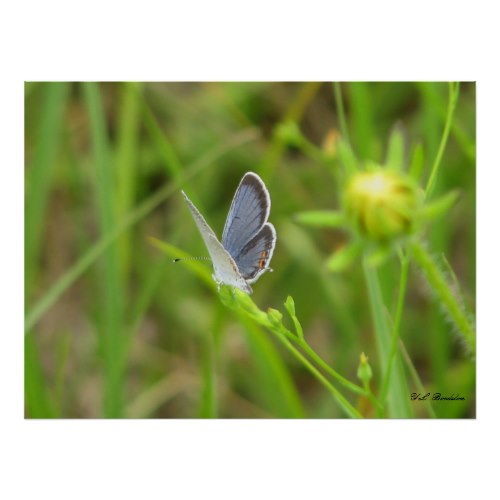
Eastern Tailed-Blue Butterfly by naturegirl7
© 2008 Yvonne L B
